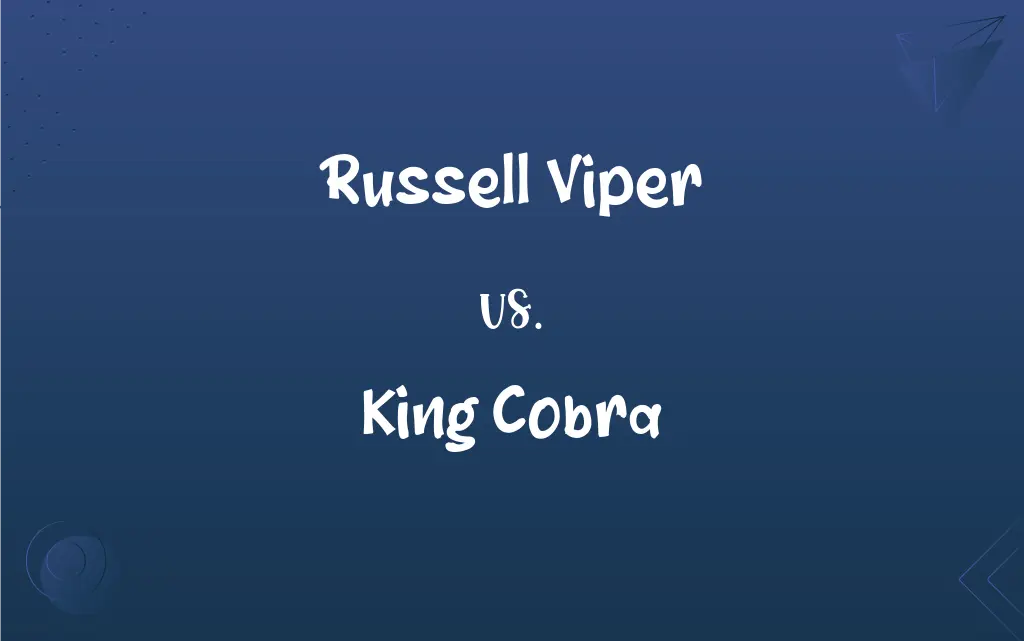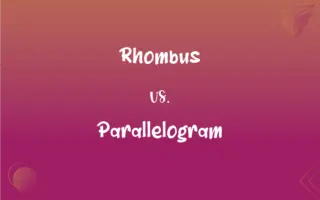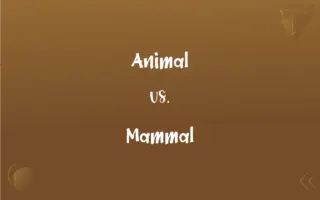Russell Viper vs. King Cobra: What's the Difference?
Edited by Aimie Carlson || By Janet White || Published on December 23, 2024
The Russell's viper is a highly venomous pit viper known for its potent bite, while the king cobra, the world's longest venomous snake, is renowned for its intelligence and ability to deliver a fatal amount of venom.

Key Differences
The Russell viper and the king cobra are both formidable snakes, revered and feared for their venomous capabilities. The Russell viper, found primarily in Asia, is known for its aggressive nature and potent venom, which causes significant blood coagulation disorders. The king cobra, on the other hand, is recognized for its impressive length, reaching up to 18 feet, and its unique ability to stand erect and expand its hood as a threat display. Both snakes occupy distinct ecological niches, with the Russell viper preferring grasslands and agricultural areas, and the king cobra residing in forests and swamplands.
The Russell viper's venom is highly toxic, causing severe pain, swelling, and sometimes fatal bleeding disorders, the king cobra's venom is neurotoxic, directly attacking the victim's nervous system and leading to paralysis or even death if untreated. The clinical effects of their bites underscore the dangers posed by these snakes to humans and highlight the importance of medical intervention following envenomation.
The Russell viper is notorious for being one of the leading causes of snakebite fatalities in Asia due to its habit of frequenting areas populated by humans. Conversely, the king cobra, despite its fearsome reputation, tends to avoid human encounters, inhabiting more secluded areas. This behavioral difference reflects the varying degrees of risk these snakes pose to humans, with the Russell viper being considered a more immediate threat in its native range.
In terms of conservation status, both species face threats from habitat destruction and persecution. However, the king cobra, with its more specialized habitat requirements, is particularly vulnerable to the effects of deforestation and environmental degradation. Efforts to conserve these species are crucial for maintaining biodiversity and the ecological balance within their respective habitats.
Despite their dangerous reputations, both the Russell viper and the king cobra play integral roles in their ecosystems as top predators. They control rodent populations and other small animals, contributing to the health of their environments. Understanding and respecting these remarkable creatures is key to coexisting with them and appreciating their place in the natural world.
ADVERTISEMENT
Comparison Chart
Venom Type
Hemotoxic, causing blood disorders
Neurotoxic, affecting the nervous system
Habitat
Grasslands, farmlands, and urban fringes in Asia
Forests and swamps in South and Southeast Asia
Behavior
Aggressive when threatened
Avoids humans but can be aggressive if cornered
Length
Up to 5 feet
Up to 18 feet, the longest venomous snake
Threat Display
None specific
Erect stance and hood expansion
ADVERTISEMENT
Russell Viper and King Cobra Definitions
Russell Viper
Conservation efforts are necessary to protect the Russell viper's habitat from degradation.
Habitat loss threatens the Russell viper, highlighting the need for environmental conservation.
King Cobra
King cobras have a unique threat display, standing erect and expanding their hood when threatened.
When confronted, the king cobra's hood expansion serves as a warning to potential threats.
Russell Viper
The Russell viper is a highly venomous snake found in Asia, known for its aggressive nature.
A farmer was hospitalized after a Russell viper bite while working in the field.
King Cobra
King cobras are known for their intelligence, including the ability to recognize their handlers.
The intelligence of the king cobra is evident in its interactions with humans in captivity.
Russell Viper
The Russell viper's bite causes severe hemotoxic effects, leading to bleeding and clotting disorders.
The venom of the Russell viper disrupts blood coagulation, making its bite particularly dangerous.
King Cobra
The king cobra is the world's longest venomous snake, capable of reaching lengths of up to 18 feet.
The king cobra's imposing size makes it a formidable predator in its natural habitat.
Russell Viper
The Russell viper plays a crucial role in controlling rodent populations.
By preying on rodents, the Russell viper helps manage pest populations and protect crops.
King Cobra
The venom of the king cobra is highly neurotoxic, targeting the nervous system of its prey.
A single bite from a king cobra can be fatal without prompt medical treatment.
Russell Viper
Russell vipers are often found in agricultural areas, where they come into contact with humans.
Russell vipers contribute to snakebite incidents in rural communities due to their proximity to human habitation.
King Cobra
Conservation efforts aim to protect the king cobra's forest habitat from destruction.
Protecting the king cobra's habitat is essential for preserving biodiversity in tropical forests.
FAQs
What is unique about the king cobra's physical appearance?
The king cobra is notable for its ability to stand erect and expand its hood as a threat display.
What is the maximum length a king cobra can reach?
King cobras can grow up to 18 feet, making them the longest venomous snake.
What role do Russell vipers play in their ecosystem?
They control rodent populations, helping to maintain ecological balance.
Where can one typically find a Russell viper?
Russell vipers are found in grasslands, farmlands, and urban fringes across Asia.
How long can a Russell viper grow?
Russell vipers can grow up to 5 feet in length.
How does the king cobra's venom affect its prey?
Its venom is neurotoxic, leading to paralysis and potentially death in its prey.
What conservation challenges do king cobras face?
King cobras face habitat destruction and persecution, threatening their survival.
What distinguishes the Russell viper's venom from that of the king cobra?
Russell viper venom is hemotoxic, affecting blood, while king cobra venom is neurotoxic, affecting the nervous system.
How does the Russell viper's behavior affect its interaction with humans?
The Russell viper's aggressive nature and tendency to inhabit human-populated areas increase its interaction and conflict with humans.
Why is the king cobra revered in some cultures?
The king cobra is revered for its imposing presence and association with strength and power in some Asian cultures.
Can Russell vipers be found in urban areas?
Yes, they can sometimes be found in urban fringes, leading to potential human-snake conflicts.
What are the signs of a Russell viper bite?
Symptoms include severe pain, swelling, and signs of bleeding or clotting disorders.
What makes the Russell viper's habitat important for its survival?
Its habitat is crucial for providing food sources and breeding grounds, influencing its distribution and population.
What is the diet of a king cobra?
King cobras primarily feed on other snakes, including venomous species.
How can one avoid encounters with king cobras in the wild?
By being cautious in their habitats, avoiding provocation, and staying away from areas where they are known to reside.
Why are Russell viper bites considered particularly dangerous?
Their bites are dangerous due to potent hemotoxic venom causing severe blood disorders.
What efforts are being made to conserve the king cobra's habitat?
Conservation efforts include habitat protection, research, and education to reduce human-snake conflicts.
How do king cobras hunt their prey?
King cobras hunt by using their keen sense of smell, stalking, and delivering a fatal bite to their prey.
What is the significance of the Russell viper in medical research?
Its venom is used in medical research to develop antivenoms and study blood coagulation disorders.
How often do Russell vipers come into contact with humans?
Quite frequently, especially in agricultural and populated areas, leading to increased snakebite incidents.
About Author
Written by
Janet WhiteJanet White has been an esteemed writer and blogger for Difference Wiki. Holding a Master's degree in Science and Medical Journalism from the prestigious Boston University, she has consistently demonstrated her expertise and passion for her field. When she's not immersed in her work, Janet relishes her time exercising, delving into a good book, and cherishing moments with friends and family.
Edited by
Aimie CarlsonAimie Carlson, holding a master's degree in English literature, is a fervent English language enthusiast. She lends her writing talents to Difference Wiki, a prominent website that specializes in comparisons, offering readers insightful analyses that both captivate and inform.





































































